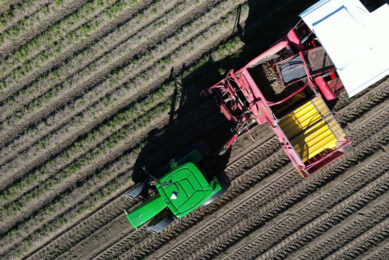Trimble CenterPoint RTX Fast: one-inch accuracy in under a minute

Trimble promises one-inch accuracy in under a minute with CenterPoint RTX Fast. How does it work? We asked Trimble 5 questions about their correction service.
Trimble has applied GPS technologies to provide real-time corrections data without interruption and survey grade accuracy from coast-to-coast in the U.S. and southern Canada via CenterPoint RTX Fast. This service eliminates the need for a base station and radio to capture highly accurate measurements. Previously, Trimble’s CenterPoint RTX Fast was only available in select regions of the U.S. and Canada. We asked Trimble five questions about CenterPoint RTX Fast.
Text continues underneath image
What is the technical difference between Trimble’s CenterPoint RTX Fast and RTK in simple words?
“RTK and CenterPoint RTX Fast both provide similar accuracy but with different underlying technology. RTK requires the use of either a temporary or permanent base station (can be in the form of VRS corrections) that is located near the user’s location and works by cancelling GNSS error sources between the local base and machine, sending this information over a radio or cellular connection.
Since the accuracy of this cancellation decreases as distance to the base station increases, the base station must be close to the operator’s machine. Trimble RTX models GNSS errors on a global scale. As such, Trimble RTX is available worldwide, can be received via satellite with no additional hardware or cellular connection, and allows users to work without the constraints of a local RTK base station(s) or VRS network.”
What costs are associated with a switch to CenterPoint RTX Fast for a farmer who now only works with the free GPS signal? And what hardware adjustments are needed for this?
“The cost associated to switch to CenterPoint RTX Fast is an annual subscription fee priced similar to many RTK networks and can be obtained from local precision ag resellers. The only other piece is ensuring you have a GPS/GNSS receiver that supports CenterPoint RTX Fast and has the necessary accuracy licenses.
Other than that, there are no additional hardware requirements such as a radio or modem. It’s a very simple and easy process to set up, extremely similar to WAAS. The takeaway is, CenterPoint RTX is a much more cost effective solution for farmers to arrive at RTK level performance than a traditional base station.”
Text continues underneath video
Why would a farmer who now works with GPS-RTK switch to CenterPoint RTX Fast?
“RTK has long been the only way to get sub-inch repeatable accuracy for precision farming – that has changed with CenterPoint RTX. Trimble was a pioneer of RTK decades ago, and has utilized that expertise to develop Trimble RTX and provide one inch performance to farmers with the ease and flexibility of satellite or cellular delivery. For farmers with an RTK system, they already have all of the necessary hardware licenses required to use CenterPoint RTX Fast and so making the change is as easy as subscribing.”
While extremely accurate, RTK does not come without limitations and points of failure that can cause downtime.
- An RTK base station is a single point of failure. If that station stops working, is stolen or damaged, has an inaccurate position, is located too far from the tractor or in an area with less than ideal GNSS visibility – the farmer is directly impacted and will have inaccurate AB lines or will be completely unable to work. Trimble RTX addresses this with a global base station network monitored 24/7 by operations engineers ensuring accurate, repeatable corrections are available whenever a farmer needs them.
- RTK is a static technology. Once a customer has invested into an RTK system, they are somewhat “locked in” to that feature set. Trimble RTX is a subscription service which is continually evolving and improving, giving farmers access to the most up to date satellite systems and corrections algorithms, with no additional costs.
- RTK is complex. Base stations rely on a radio data link which introduces more hardware to troubleshoot. Customers in hilly / forested land often require a radio repeater for full farm coverage. For a typical RTK set up, there is one base station, two radios, (sometimes an additional radio repeater) and a GNSS receiver on a tractor. Because Trimble RTX can be received via satellite with the hardware already built into the GNSS receiver, all of the extra equipment (and so points of failure), are eliminated.”
Which independent studies show that RTX-fast is as (or almost as) accurate as RTK?
“Surveyors have been chasing the last centimeter for decades. This article speaks about the generics of PPP (which is the method utilized by Trimble RTX) and how it has evolved, but cites the performance of Trimble RTX specifically. We are always looking for partners to run agriculture specific studies, and would welcome further discussion if you’d be interested in partnering on this.”
CenterPoint RTX Fast; now for farmers in North America and Canada. When can other farmers in the world also use RTX Fast?
“Most farmers in Western Europe are also covered by the Trimble RTX Fast network. We are constantly evaluating the market for any future network development. While PPP corrections do have (historically longer) convergence times, CenterPoint RTX actually provides industry leading convergence times and farmers can achieve FULL accuracy in under 20 minutes, and can get started working at lower accuracy much sooner, anywhere in the world.”
Join 17,000+ subscribers
Subscribe to our newsletter to stay updated about all the need-to-know content in the agricultural sector, two times a week.



